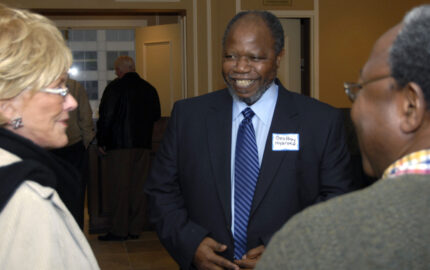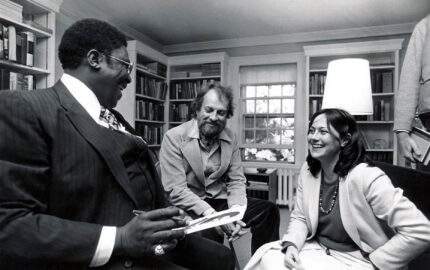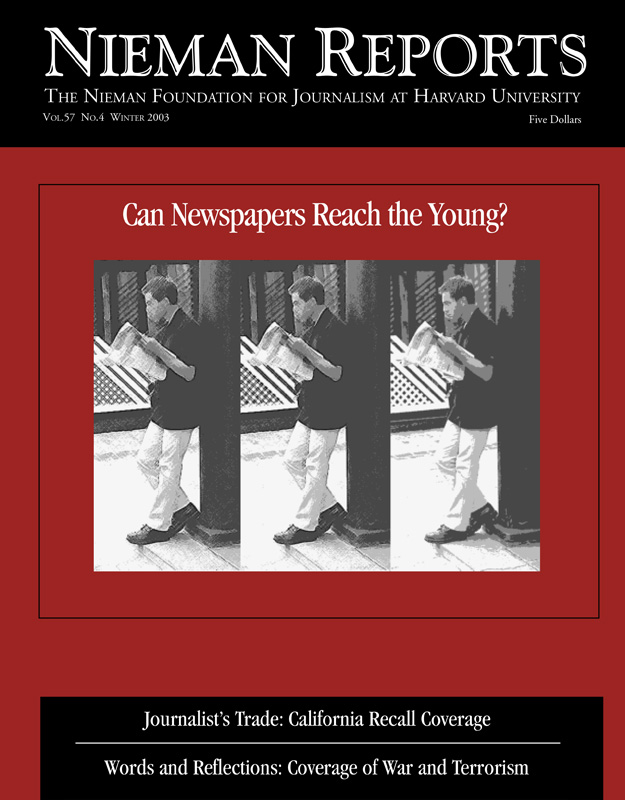
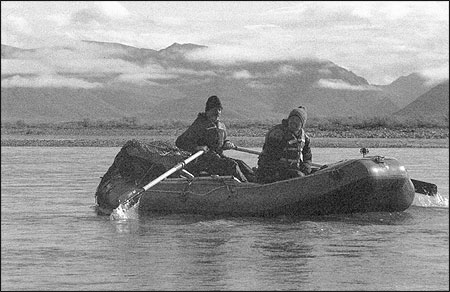
Richard Read, of The Oregonian, rows with Nicholas D. Kristof, of The New York Times, on the Canning River below Alaska’s Brooks Range. Read, Kristof and Naka Nathaniel, of www.nytimes.com, spent five days floating north toward the Arctic Ocean. Photo by Naka Nathaniel.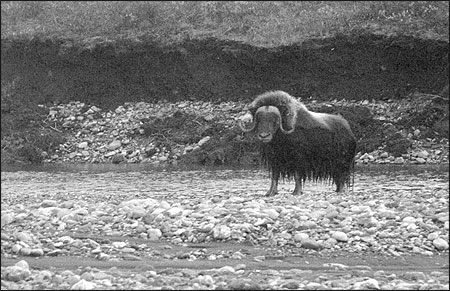
A musk ox eyes rafters from a gravel bar in the Canning River. The rugged animals, wiped out in Alaska by hunters during the 1800’s, were reintroduced from Greenland beginning in the 1930’s. Photo by Naka Nathaniel.
Pontificators often sound flat when they write about subjects—grizzly bears, say, or whales—that they haven’t actually seen or tasted. That’s one reason I jumped at the invitation to backpack in the Arctic National Wildlife Refuge with Nicholas D. Kristof, peripatetic columnist for The New York Times, who called out of the blue last summer.
I don’t write opinion, at least not consciously. Neither did Nick when we first met in 1989 at adjacent telex machines in Pyongyang, North Korea. But Nick, who travels to the ends of the earth to report his op-ed column, planned to explore the Alaskan refuge where the Bush administration favored drilling for oil.
Perhaps Nick called me believing that no New Yorker would be crazy enough to go along. Or maybe he merely figured that Oregon, his home state and my adopted one, was on the way to Alaska. In any case, Nick called back a few days later. “Uh,” he said, “you have done some hiking before, haven’t you?”
Those who write columns without hiking, or without at least moving from their keyboards, run certain risks. So do people who brave grizzlies, polar bears, blizzards, severe cold, and rickety bush planes in America’s most remote preserve. But Walt Audi, a bush pilot Nick located, was reassuring when I reached him by phone as he flipped burgers for his hotel guests in Kaktovik, Alaska. Walt said he’d throw in some bear spray for us.
Bear spray? “If a bear attacks you, just spray yourself in the face, and you won’t see it.”
I passed along this tip to the third member of our party, Naka Nathaniel, Paris-based multimedia man for the Times’s Web site, figuring he might opt out. I thought Nick himself might not make it, given that he described in his column getting a car stuck in Ukraine the week before our rendezvous.
But we met in a Fairbanks’ hotel in late August. Fog stranded us the next day in Deadhorse, the aptly named gateway to the Prudhoe Bay oil fields. A commercial pilot generously agreed to drop us in Arctic Village beside the refuge. On the fly, he arranged for passing bush pilot Dirk Nickisch to ride us in from there.
Winging over the spectacular Brooks Range in his 1952 DeHavilland Beaver, Nickisch popped a question. “Hey, you guys want to do a raft trip?” It turned out he was retrieving a group of vacationing oil company geologists who happened to have an inflatable raft belonging to Walt Audi.
And so we bounced to a stop on a Canning River gravel bar, to be served chicken pesto tortellini, red wine, fresh chocolate cheesecake, single-malt Scotch, cigars and the remains of four kegs of beer. After the nine Arctic bon vivants flew out, we saw not a footprint, not a shred of plastic, and not a cigarette butt during five magical days floating 40 miles toward the Arctic Ocean.
The first grizzly showed up conveniently at breakfast, enabling Nick to file an add to his column by satellite phone. The second grizzly, a towering tawny animal, seemed to find nearby musk oxen more appetizing than journalists.
The refuge was so pristine that some caribou actually approached us. “They seemed to be trying to determine whether we were pitifully deformed caribou,” Nick wrote.
The vast tundra blazed with autumn color like a treeless New England in places, complete with succulent blueberries. Hummocks of vegetation and water trapped above permafrost made hiking difficult. On my birthday, we lit candles amid a stiff 40-degree breeze.
Nick floated an opinion as we bobbed along: The refuge could be opened to oil exploration and drilling as part of a grand bargain on the environment that would also address global warming. The government would break the environmental policy deadlock by increasing vehicle mileage standards, controlling carbon emissions, and subsidizing alternative energy.
I thought it would make a fine column. I also thought it was a lousy idea. Why should caribou suffer the sins of Hummer drivers? But as I say, I don’t write opinion.
Walt flew us out as promised to Kaktovik, an island village closer to Greenland than to Oregon and closer to Finland than to New York. Never mind that Walt’s Cessna crashed the next day as he kindly tried to remove some wayward rafters from a mudflat. “Survived another one,” he said with a shrug.
In Kaktovik we watched hungry polar bears circle as Inupiats hauled ashore a 43-foot bowhead whale amid snow flurries and celebration. Whale meat, we found, goes down far better drenched in ketchup.
Nick got five great columns out of the trip before departing New York for Africa. Naka produced stunning, narrated slide shows of our adventures. All in all, Nick went easier on the caribou in print than I thought he might. He called the administration’s attempted assault on primordial wilderness shameful.
What would Huck Finn have said? There’s nothing like a river trip, a shot of whiskey, and a chunk of blubber to open a person’s eyes.
Richard Read, a 1997 Nieman Fellow, covers international affairs at The Oregonian. To read Nicholas D. Kristof’s columns and to see Naka Nathaniel’s audio slide shows, visit: http://topics.nytimes.com/top/opinion/
editorialsandoped/oped/columnists/nicholasdkristof/index.html?8qa
